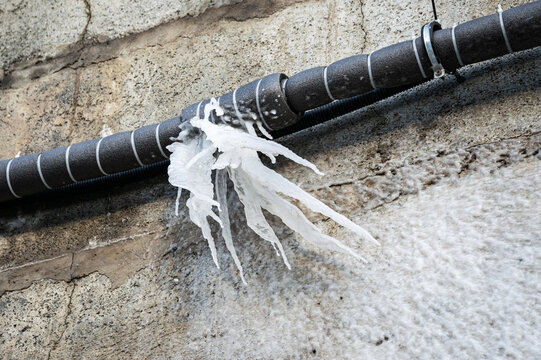How to Protect Your Plumbing from Freezing: Critical Strategies
How to Protect Your Plumbing from Freezing: Critical Strategies
Blog Article
They are making a few great annotation on 6 Ways to Prevent Frozen Pipes overall in this article underneath.

Cold weather can ruin your plumbing, particularly by freezing pipelines. Here's exactly how to stop it from happening and what to do if it does.
Introduction
As temperatures decline, the risk of icy pipelines boosts, possibly causing expensive repair work and water damages. Understanding how to prevent frozen pipelines is important for property owners in chilly environments.
Recognizing Frozen Pipelines
What causes pipelines to ice up?
Pipelines freeze when subjected to temperatures below 32 ° F (0 ° C) for prolonged durations. As water inside the pipes ices up, it expands, putting pressure on the pipeline walls and possibly causing them to rupture.
Dangers and damages
Icy pipes can bring about water supply disturbances, residential or commercial property damages, and costly repair services. Burst pipelines can flood homes and cause considerable structural damage.
Indicators of Frozen Pipes
Identifying icy pipes early can prevent them from bursting.
How to recognize icy pipes
Try to find lowered water circulation from faucets, uncommon odors or noises from pipes, and visible frost on subjected pipelines.
Avoidance Tips
Protecting prone pipes
Wrap pipes in insulation sleeves or use warm tape to safeguard them from freezing temperatures. Concentrate on pipelines in unheated or external areas of the home.
Heating methods
Maintain indoor spaces properly warmed, specifically locations with pipes. Open up cupboard doors to allow warm air to circulate around pipes under sinks.
Securing Exterior Plumbing
Yard tubes and outside taps
Disconnect and drain garden tubes before winter. Install frost-proof spigots or cover outdoor taps with protected caps.
What to Do If Your Pipes Freeze
Immediate actions to take
If you think frozen pipes, keep faucets open up to eliminate stress as the ice melts. Use a hairdryer or towels soaked in warm water to thaw pipelines slowly.
Long-Term Solutions
Structural adjustments
Consider rerouting pipes away from outside wall surfaces or unheated areas. Include added insulation to attic rooms, basements, and crawl spaces.
Upgrading insulation
Invest in premium insulation for pipes, attics, and walls. Proper insulation aids preserve regular temperature levels and minimizes the threat of frozen pipes.
Conclusion
Preventing frozen pipes requires proactive steps and quick feedbacks. By understanding the causes, signs, and preventive measures, homeowners can protect their plumbing throughout winter.
6 Proven Ways to Prevent Frozen Pipes and Protect Your Home
Disconnect and Drain Garden Hoses
Before winter arrives, start by disconnecting your garden hoses and draining any remaining water. Close the shut-off valves that supply outdoor hose bibs and leave the outdoor faucet open to allow any residual water to drain. For extra protection, consider using faucet covers throughout the colder months. It’s also important to drain water from any sprinkler supply lines following the manufacturer’s directions.
Insulate Exposed Pipes
Insulating your pipes is an effective way to prevent freezing. Pipe insulation is readily available at home improvement stores and is relatively inexpensive. Pay close attention to pipes in unheated areas such as the attic, basement, crawl spaces, or garage. Apply foam insulation generously to create a buffer against the cold. You can also wrap your pipes in heat tape or thermostat-controlled heat cables for added warmth.
Seal Air Leaks
Inspect your home for any cracks or openings that could let in cold air. Seal any holes around the piping in interior or exterior walls, as well as the sill plates where your home rests on its foundation. Additionally, make sure to keep your garage door closed unless you’re entering or exiting. Leaving it open creates a significant air leak that can lead to frozen pipes.
Allow Warm Air Circulation
During cold snaps, it’s essential to allow warm air to circulate evenly throughout your home. Leave interior doors ajar to promote better airflow. Open kitchen and bathroom cabinets to help distribute heat consistently around the rooms. If you have small children or pets, be sure to remove any household chemicals or potentially harmful cleaners from open cabinets for safety.
Let Faucets Drip
A small trickle of water can make a big difference in preventing ice formation inside your pipes. When temperatures drop significantly, start a drip of water from all faucets served by exposed pipes. This continuous flow helps prevent the water from freezing. Additionally, running a few faucets slightly can relieve pressure inside the pipes, reducing the chances of a rupture if the water inside does freeze.
https://choateshvac.com/6-proven-ways-to-prevent-frozen-pipes-and-protect-your-home/

I have been very excited about How To Avoid Freezing Pipes and I hope you liked the entire article. For those who liked our blog entry plz remember to pass it around. Thanks so much for going through it.
More Details Report this page